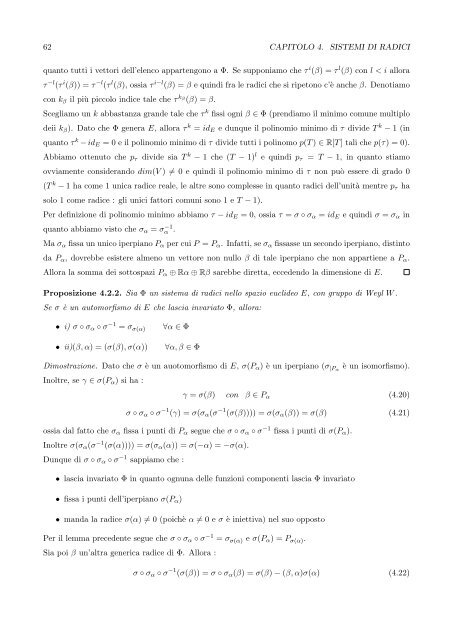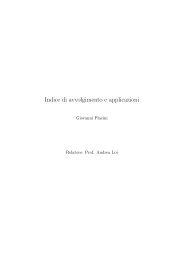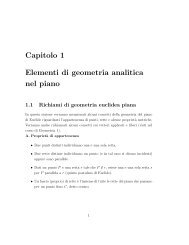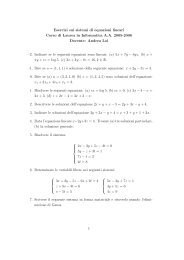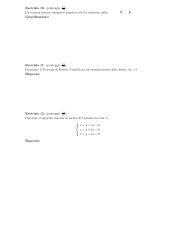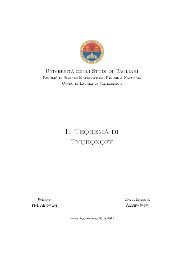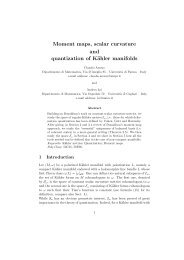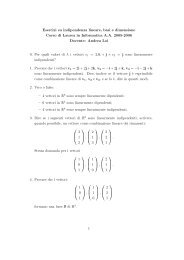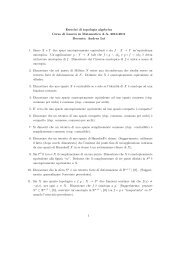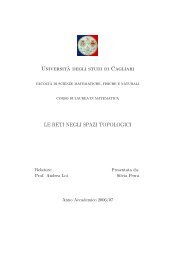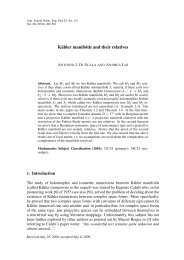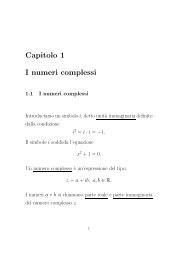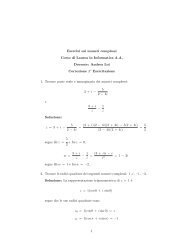Algebre di Lie semisemplici, sistemi di radici e loro classificazione
Algebre di Lie semisemplici, sistemi di radici e loro classificazione
Algebre di Lie semisemplici, sistemi di radici e loro classificazione
Create successful ePaper yourself
Turn your PDF publications into a flip-book with our unique Google optimized e-Paper software.
62 CAPITOLO 4. SISTEMI DI RADICI<br />
quanto tutti i vettori dell’elenco appartengono a Φ. Se supponiamo che τ i (β) = τ l (β) con l < i allora<br />
τ −l (τ i (β)) = τ −l (τ l (β), ossia τ i−l (β) = β e quin<strong>di</strong> fra le ra<strong>di</strong>ci che si ripetono c’è anche β. Denotiamo<br />
con kβ il più piccolo in<strong>di</strong>ce tale che τ kβ(β) = β.<br />
Scegliamo un k abbastanza grande tale che τ k fissi ogni β ∈ Φ (pren<strong>di</strong>amo il minimo comune multiplo<br />
deii kβ). Dato che Φ genera E, allora τ k = idE e dunque il polinomio minimo <strong>di</strong> τ <strong>di</strong>vide T k − 1 (in<br />
quanto τ k − idE = 0 e il polinomio minimo <strong>di</strong> τ <strong>di</strong>vide tutti i polinomo p(T ) ∈ R[T ] tali che p(τ) = 0).<br />
Abbiamo ottenuto che pτ <strong>di</strong>vide sia T k − 1 che (T − 1) l e quin<strong>di</strong> pτ = T − 1, in quanto stiamo<br />
ovviamente considerando <strong>di</strong>m(V ) = 0 e quin<strong>di</strong> il polinomio minimo <strong>di</strong> τ non può essere <strong>di</strong> grado 0<br />
(T k − 1 ha come 1 unica ra<strong>di</strong>ce reale, le altre sono complesse in quanto ra<strong>di</strong>ci dell’unità mentre pτ ha<br />
solo 1 come ra<strong>di</strong>ce : gli unici fattori comuni sono 1 e T − 1).<br />
Per definizione <strong>di</strong> polinomio minimo abbiamo τ − idE = 0, ossia τ = σ ◦ σα = idE e quin<strong>di</strong> σ = σα in<br />
quanto abbiamo visto che σα = σ −1<br />
α .<br />
Ma σα fissa un unico iperpiano Pα per cui P = Pα. Infatti, se σα fissasse un secondo iperpiano, <strong>di</strong>stinto<br />
da Pα, dovrebbe esistere almeno un vettore non nullo β <strong>di</strong> tale iperpiano che non appartiene a Pα.<br />
Allora la somma dei sottospazi Pα ⊕ Rα ⊕ Rβ sarebbe <strong>di</strong>retta, eccedendo la <strong>di</strong>mensione <strong>di</strong> E.<br />
Proposizione 4.2.2. Sia Φ un sistema <strong>di</strong> ra<strong>di</strong>ci nello spazio euclideo E, con gruppo <strong>di</strong> Weyl W .<br />
Se σ è un automorfismo <strong>di</strong> E che lascia invariato Φ, allora:<br />
• i) σ ◦ σα ◦ σ −1 = σ σ(α)<br />
∀α ∈ Φ<br />
• ii)(β, α) = (σ(β), σ(α)) ∀α, β ∈ Φ<br />
Dimostrazione. Dato che σ è un auotomorfismo <strong>di</strong> E, σ(Pα) è un iperpiano (σ |Pα<br />
Inoltre, se γ ∈ σ(Pα) si ha :<br />
è un isomorfismo).<br />
γ = σ(β) con β ∈ Pα (4.20)<br />
σ ◦ σα ◦ σ −1 (γ) = σ(σα(σ −1 (σ(β)))) = σ(σα(β)) = σ(β) (4.21)<br />
ossia dal fatto che σα fissa i punti <strong>di</strong> Pα segue che σ ◦ σα ◦ σ −1 fissa i punti <strong>di</strong> σ(Pα).<br />
Inoltre σ(σα(σ −1 (σ(α)))) = σ(σα(α)) = σ(−α) = −σ(α).<br />
Dunque <strong>di</strong> σ ◦ σα ◦ σ −1 sappiamo che :<br />
• lascia invariato Φ in quanto ognuna delle funzioni componenti lascia Φ invariato<br />
• fissa i punti dell’iperpiano σ(Pα)<br />
• manda la ra<strong>di</strong>ce σ(α) = 0 (poichè α = 0 e σ è iniettiva) nel suo opposto<br />
Per il lemma precedente segue che σ ◦ σα ◦ σ −1 = σ σ(α) e σ(Pα) = P σ(α).<br />
Sia poi β un’altra generica ra<strong>di</strong>ce <strong>di</strong> Φ. Allora :<br />
σ ◦ σα ◦ σ −1 (σ(β)) = σ ◦ σα(β) = σ(β) − (β, α)σ(α) (4.22)


